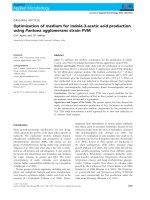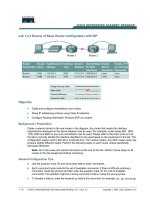3 modes of assessment
Bạn đang xem bản rút gọn của tài liệu. Xem và tải ngay bản đầy đủ của tài liệu tại đây (1.35 MB, 50 trang )
+
UW-Whitewater
Languages and Literatures
Ellen Titzkowski Boldt
August 6, 2014
Summer Assessment Workshop for High School World
Language Instructors
The Three Modes of Assessment: Interpretive,
Interpersonal, Presentational
+
Overview
Understanding Assessment
Designing Assessments
Implementing Assessments
Evaluating Assessments
+
Overview
Introduction
The Purpose of Assessment
Attitudes Towards Assessment
Intended Use of Assessments
Developing Effective Assessments
Types of Assessments
Integrated Performance Assessments (IPA)
The Three Modes of Communication
Assessing the Modes: Tasks & Strategies
Designing Performance Assessments
Rubrics
Why is assessment important?
+
Why do we keep doing it in our classrooms,
despite the challenges it can present?
+
The Purpose of Assessment
To motivate students
To serve as more than a vehicle to assign a grade
To drive the instruction (Sandrock 2010)
To show evidence that learning is occurring
To evaluate the effectiveness of instruction
To identify areas needed for improvement
+
The Purpose of Assessment
Assessment is used as a diagnostic tool to
describe what students have learned in the past
shape future learning goals
document progress towards student learning objectives
identify areas needing improvement (in instruction and student performance)
measure language proficiency, communicative competency, and cultural awareness
evaluate teacher effectiveness*
WI Educator Effectiveness System DPI
*Starting in 2014-2015, all WI educators will be evaluated on student achievement & student learning
objectives/outcomes (SLOs).
See for the latest information.
+
The Purpose of Assessment
“Language assessment is the process of using language tests to accomplish
particular jobs in language classrooms and programs” (42).
“To keep our language assessment practice purposeful, we therefore need to
evaluate the extent to which the language testing tools we select and use are
actually helping to accomplish the jobs of language assessment in our
classrooms and programs” (44).
(Norris 2000/2012)
+
Attitudes towards Assessment
/>
+
Attitudes towards Assessment
/>
+
Assessment Stakeholders: How do different groups view
assessment and why?
Stakeholders
Teachers
Students
Administrators
Students’ Families
Curriculum planners
Future employers
University admissions counselors
Step 1: Brainstorm individually
Goals?
Attitudes?
Problems?
Step 2: Share and compare
Discuss ideas with a partner.
Focus on differing motivations.
(Norris 2000)
Drag picture to placeholder or
+
click icon to add
What makes a good
assessment?
Drag picture to placeholder or
click icon to add
Discuss in pairs.
+
Quality and Selection:
What makes a good assessment?
TRICK QUESTION!
The selection and perceived quality of an assessment
depends on its intended use.
+
Intended Use of Assessments
WHO?
WHAT?
Test
Test
Users
Information
INTENDED
TEST USE
IMPACT?
WHY?
Test
Test
Consequences
Purposes
(Norris 2000)
+
Developing Effective Assessments
Key questions to ask when creating/selecting the right assessment:
Who uses the assessment?
What is being assessed?
Who/What is impacted?
Why? What is the purpose?
Specify the intended use of the assessment.
Provide a general description of the intended assessment.
Note problems and possible solutions.
(Norris 2000)
+
Developing Effective Assessments
Purposeful language assessment requires:
Acknowledging the context for assessment
Focusing on assessment, not just on tests
Specifying the intended use(s) of the assessments(s)
Evaluating the outcomes of the assessment(s)
(Byrnes 2001; Norris 2000)
+
Developing Effective Assessments
What does purposeful assessment look like?
Identifying the thematic and cultural contexts
Setting attainable benchmarks or learning targets
Creating classroom activities to support student success on performance
assessments
Synthesizing language and content instruction
Fostering task-based instruction
Developing both formative and summative assessments
Involving all three modes of assessment
Embedding assessments into curriculum
+
Assessment Models
Common Assessments
Level- and course-specific assessments
Formative vs. Summative vs. Prototypical
Exit interviews (OPI, SOPI, MOPI)
Content-based, task-based, genre-specific
Performance Assessments
Three Modes of Communication
5 C’s of the National Standards
+ Types of Assessments
Traditional
Alternative Performance Assessment
Assessment Tools
Tools
Focus on:
grammatical accuracy
focus on form
vocabulary building
discrete learning checks
Focus on:
communication
application of learning
authentic language use
performance of real world tasks
meaningful contexts
proficiency development
integration with standards
3 modes of communication
teaching to the “test”
(Sandrock 2010)
+
Types of Assessments
Assessment is a continuum.
Teachers need to provide students with a variety of feedback on various
types of assessment across the spectrum, including:
specific and focused feedback
holistic and broad feedback
Formal (rubrics) and informal (learning checks) feedback
A balanced assessment system = both formative and summative
assessments.
(Sandrock 2010)
+ Types of Assessments
Formative Assessment
Summative Assessment
Learning checks, guided activities with teacher
support
End-of-unit, end-of-course assessment (no
support)
Informs and modifies instruction, classroom
activities and student learning
Demonstrates knowledge gained without
teacher assistance
Motivates students
Scaffolds information to be used in summative
performance assessments
Showcases application of various skills learned
via formative assessments
May focus more on specific learning targets (i.e.
grammar concepts, vocabulary)
Synthesizes a variety of communication skills
and language concepts
Builds students’ confidence
+
Characteristics:
The 3 Modes of Communication
Interpretive Mode:
listening, reading, viewing
authentic, text-based (audio, written, video/film) materials
monologic tasks (one-way communication)
Interpersonal Mode:
spontaneous communication (oral or written)
negotiation of meaning
dialogic tasks (two-way communication)
Presentational Mode:
speaking, writing
monologic tasks (one-way communication)
Rehearsed language usage
+ The 3 Modes of Communication
Interpersonal
Active negotiation of meaning among individuals
Interpretive
Interpretation of what the author, speaker, or producer
Presentational
Creation of messages
wants the receiver of the message to understand
Participants observe and monitor one another to see how
One-way communication with no recourse to the active
One-way communication intended to facilitate
their meanings and intentions are being communicated
negotiation of meaning with the writer, speaker, or
interpretation by members of the other culture where no
producer
direct opportunity for the active negotiation of meaning
between members of the two cultures exists
Adjustments and clarifications are made accordingly
Interpretation differs from comprehension and translation in
To ensure the intended audience is successful in its
that interpretation implies the ability to read (or listen or
interpretation, the “presenter” needs knowledge of the
view) “between the lines,” including understanding from
audience’s language and culture
within the cultural mindset or perspective
Speaking and listening (conversation); reading and writing
Reading (websites, stories, articles), listening (speeches,
Writing (messages, articles, reports), speaking (telling a
(text messages or via social media)
messages, songs), or viewing (video clips) of authentic
story, giving a speech, describing a poster), or visually
materials
representing (video or PowerPoint)
(ACTFL Performance Descriptors for Language Learners 2012)
+ Standards-Based Performance Assessment
Interactive graphic: />
+
Assessment: Interpretive Mode
How do you typically assess students’ abilities to communicate in the
interpretive mode?
+ Assessment: Interpretive Mode
Interpretive Assessment Task =
Demonstrate literal comprehension (keys words, main ideas, details) and interpretive
comprehension (word and concept inferences, cultural perspectives, author intent, text organization).
Use a comprehension guide (worksheets, Q&A, creating or identifying images based on descriptions,
etc.) to document both levels of comprehension.
Strategies for Developing Interpretive Communication
Routinely incorporate authentic listening, viewing, and reading texts/tasks into classroom instruction
skimming, scanning, identifying language patterns.
Encourage focused listening/viewing/reading of smaller textual chunks and teach comprehension
strategies context clues, word families, textual organization (headings, captions, photos).
Design group activities that allow for collaborative interpretive skills.
Assist students as they move from literal comprehension to interpretive comprehension goals.
(Sandrock 2010: 83)









